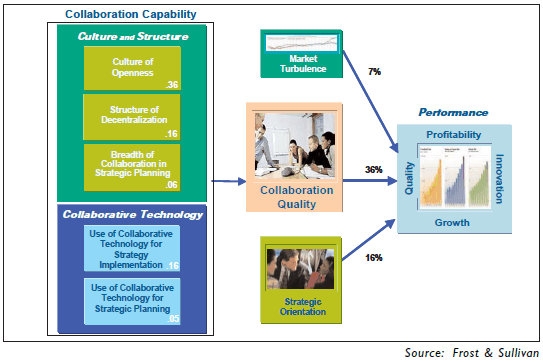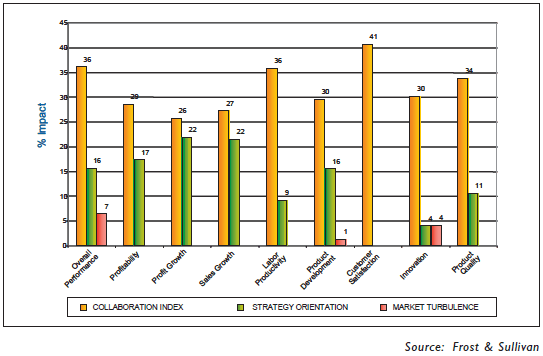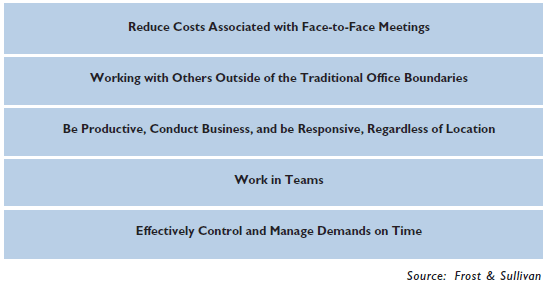When you really think about it, collaboration is at the very heart of every business on the planet. It’s very rare that you find someone that is isolated from the rest of the company. Most people are a part of a team that needs to work together to achieve the best possible results; that team is a part of many teams that all need to work together to help grow an enterprise. We collaborate in pretty much everything we do at work, it’s not always efficient and it’s not always effective, but what if it were?
Frost & Sullivan along with Verizon Business and Microsoft conducted research around the impact of collaboration within the enterprise. The results of the study showed that collaboration is a key driver of company performance (the study was conducted in 2006). A global collaboration index model was developed which looked at variable factors that affect collaboration as well as several variables that affect company performance.

A culture of openness contributed 36% to collaboration quality whereas the impact of a structure of decentralization or use of collaborative technology in strategy implementation each contributed 16% to collaboration quality. Again the largest factor for collaboration quality had nothing to do with technology but with people an culture. Strategic planning and collaboration technology for strategic planning (not implementation) each contributed 6% and 5%, respectively.
The highlight of the research project was that 36% of a company’s performance was due to its collaboration index, 16& was due to strategic orientation and 7% was due to market and technological turbulence influence. Here is how collaboration affected the various aspects of business performance:

From the key numbers from the chart, collaboration impacts:
- Profitability by 29%
- Sales growth by 27%
- Profit growth by 26%
- 41% of forces driving customer satisfaction
- Productivity by 36%
- Product quality by 34%
- Product development by 30%
- Innovation by 30%
I found the report to be very interesting and definitely deserves a considerable amount of attention in the Enterprise 2.0 space. I haven’t found a report as comprehensive as this one yet (have you?). This report was released in 2006 and it would be very interesting to see how these numbers have changed over the past four years. If you ask me, this report needs to be placed in front of every key decision maker at every enterprise company. This report is a great starting point to help build the case for Enterprise 2.0 and is greatly supported by the list of over 50 Enterprise 2.0 case studies that I have found online. The question after all of this becomes, now what?
We have an analytical report supported by over 50 case studies and examples of Enterprise 2.0 implementation but this doesn’t change the fact that many collaboration challenges still exist. It’s interesting to note that the report doesn’t once mention the term ‘Enterprise 2.0’ (perhaps not coined yet) but the concept and idea behind collaboration and Enterprise 2.0 is very much in sync.
At the time this report was created, many of the popular enterprise software vendors such as Blue Kiwi, Jive, Social Text, and Spigit were either yet formed or just getting started, yet collaboration wasin full swing. Further evidence support the notion that collaboration is centered around people and not around technology. Technology can facilitate more efficient forms of collaboration and knowledge sharing but its effectiveness is an issue of deep and widespread integration and adoption. Collaboration needs to be addressed from and individual and an enterprise benefit standpoint. The enterprise benefits have been discussed extensively and include things such as reduced costs, improved innovation and ideation, and improved company performance (see chart above). However, there are also individual benefits of effective collaboration which Frost & Sullivan have clearly identified:

The challenge that I believe we are seeing today in Enterprise 2.0 is a very strong focus and push around tools instead of strategy. Collaboration is nothing new and goes back to caveman days where teams had to work together to hunt animals. Cavemen didn’t have an enterprise social software platform to discuss ideas around where and how to hunt, yet they still managed to do a fantastic job of hunting. Why then today are we so focused on platforms and tools when the real issue is around culture and people? I’ll talk more about some of the potential hurdles (as well as other topics) in the near future, but for now read and digest the report so we can discuss it.
What do you think of the report? Is there anything especially interesting that jumps out at you? Did I miss or overlook something?
I highly recommend that you read the full report on the impact of collaboration as there are several other key points of interest that are worth reading.

What a fantastic resource. Thanks for sharing it here. I've always said its the people who make the difference when it comes to collaboration ( not just people, purpose too, see http://www.dynamicalsoftware.com/purpose/people… for more on that) So when you say a third of collaboration quality comes from a culture of openness then the statistics verify the human quotient.
Pingback: Business Storytelling Social Media Marketing PR & Technology Curated Stories Mar. 19, 2010
this article very well written thanks, some more articles on similar lines are welcome
Pingback: ME2: Practice Safe Social « TheBrycesWrite
Hi! I loved your post! In fact I wrote a little article about it on my blog http://condiminds.tumblr.com/ , it's a spanish comment on yours and on the 'impact of collaboration' report. I loved to see there were a lot of things writen about Enterprise 2.0 before it even exists, we work a lot with companies trying to make them understand that it's not only a software implamantation, but a change of culture. This kind of reports helps a lot!
Thanks!
I like the collaoration impact in %tages, the most. You have refined it very effectively and thus creating a good post to read. collaboration is the “buzzword” in todays world.
I like the collaoration impact in %tages, the most. You have refined it very effectively and thus creating a good post to read. collaboration is the “buzzword” in todays world.
Pingback: Does Collaboration Impact Business Performance?
Huh, that's awesome you found this, as I've been talking a lot about how improving collaboration doesn't really have anything to do with tools, but didn't have any numbers like this to back it up. I wonder too if even the percentage of technology making a difference is influenced at all by surveying the CTOs and CEOs, etc. who paid major dollars for technology implementations. If I was a CTO who had a million dollar installation of whatever wiz bang thing there was, I'm pretty sure I'm listing technology as something very important to our collaboration efforts, just in order to cover my butt if shareholders are reading this thing.
Read the final installment of a four part series on the merits of collaboration to achieve sustainable goals by leading sustainability author Richard Matthews. http://bit.ly/poVC5L
Richard Matthews is a consultant, sustainable investor, writer and owner of The Green Market. The Green Market is an award winning business blog that covers the convergence of sustainable capitalism and the global environment. Richard is a contributor to more than 50 publications including, The Green Economy Post and Environmental News Network (ENN). Find him on Facebook and Linkedin and see The Green Market’s twitter feed and Facebook Fan Page.
What’s the difference between Innovation and Product Development?